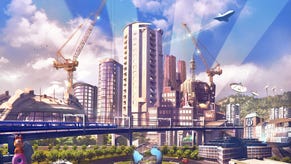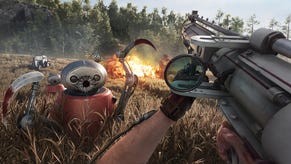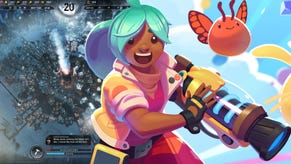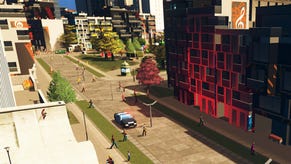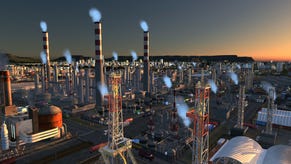Cities: Skylines - Hope For Heartbroken SimCity Fans?
Hot Town
Last year's SimCity disappointed me. Beautifully presented, it was nevertheless cramped, buggy, and content to throw thousands of simoleons at me no matter how good or bad I was at my job. It broke my heart a tiny bit. When I heard that Colossal Order were working on Cities: Skylines, I wondered if they might just pick up the pieces. Already experts on making games about transport and infrastructure, their pedigree suggested that Cities: Skylines might just be the civil engineer-cum-defibrillator that I needed to fix everything.
Sitting down to watch Colossal Order CEO Mariina Hallikainen play with a very early build of the game, I found everything remarkably recognisable, perhaps even too familiar. Cities: Skylines looks an awful lot like the the last SimCity and that's not simply because it demands a floating, eye-of-God perspective and buttons for laying down roads or stretching out industrial estates. Its interface is laid out in a very similar way. Many of the overlays work in a very similar way. I'm immediately reminded of how the Warlock games, also published by Paradox, looked very much like a fantasy mod for Civilization V.
Things begin in the same way, too. The playing area looks small. It's two kilometres square and a single, atrophied junction connects it to a huge highway that runs straight and true across one edge of the map.
If it sounds like there's plagiarism going on here, I'll pole-vault my way to a conclusion. As Hallikainen starts to navigate her way around several increasingly large cities, it's obvious that there are many more cogs turning inside Cities: Skylines and, unlike the rather opaque SimCity, this is a game that's much happier to show me what's happening and why.
For a start, city growth is gated. Hallikainen explains that the development team didn't want to present players with a tutorial that developed a city they'd then never see again. Instead, they wanted players to progress naturally through city development, gradually being introduced to new concepts one after another. Reaching certain straightforward milestones unlocks larger playing areas, new utilities and also higher density zoning. It's more like a gradual take off, rather than a rude nudge out of the nest.
Then there are the citizens, those persistent, individual citizens that were the stuff of SimCity legend. Each one is tracked as they go about their daily business and Hallikainen shows me a pharmacy, a small corner shop that would usually employ nine people. A dialogue box displays a staff breakdown, dividing roles by the education level required. Right now, it needs more employees. Specifically, it needs more well-qualified employees, but the small town it's made its home in doesn't have the colleges and universities that could provide them.
We follow a woman called Anna as she walks from her home to a job in a factory. We can see not just where she's headed (currently where she works; potentially anywhere else), but also how happy she is and even how educated. Curious, I think, that she's decided to walk to work, though I appreciate our shared preference for leg-propelled travel. Anna, I learn, will eventually die and probably occupy one of the city's cemeteries. More citizens will be born, live, and die, their routines and needs changing with their age. Hallikainen says that the largest maps can support up to a million of these tiny little lives.
For every familiarity, every element or feature that reminds me of SimCity, there's a surprise behind it. Hallikainen shows me wind turbines, coal plants and waste incinerators, but then I notice how the game isn't just tracking how much pollution they produce, but also how much noise pollution they produce. That incinerator may be burning your old VHS tapes and farting toxic gas into the sky, but it's doing so very, very quietly.
Even zoning demonstrates a little more depth. Industrial, residential and commercial zones can be drawn out with brushes of different sizes, neatly divided down to the tiniest elements. If you'd like a small corner shop at the end of a residential street, you can have it.
Of course, there's also the roads, the railways and the bus routes that Hallikainen sets up with a few quick clicks (when it comes to modelling transport and infrastructure, Colossal Order's niche but well-respected Cities in Motion series has shown diligence and attention to detail). Roads curve, bridges rise up and ridiculous spaghetti junctions that could only have boiled out of the crazed mind of a criminal pasta chef become a terrifying reality. But I think I like the districts the most.
With the same ease that she daubed industrial zones onto the map, Hallikainen divides up one burgeoning town into different districts, each of which can have particular laws, rules or restrictions governing it. A tiny voice in the back of my mind tells me that this is the route to gerrymandering, that most amusingly-named of crimes, but this is both a practical act and also one of personalisation. Districts can be given tax relief, traffic limits, even a ban on high-rise buildings. I notice, among the many options, one to ban the recognition of same-sex partnerships. I interrupt to ask about it
“We wondered, should we have that?” Hallikainen says. “Because we thought it should be the standard that same sex relationships are included. It'll be interesting to see if the option to ban them makes it into the final version. One journalist we showed the game to suggested it should be the other way around, that there should be an option in a district to allow same sex relationships.”
Then there's the dam. I like the dam, too, because it feels powerful. It's the strong and silent type. Hallikainen explains that the development team have the benefit of one member who is working on a PhD on fluid simulation, a notoriously difficult thing to do in software. Water backs up behind the dam and gushes through the centre. When she puts down her sewer outflow pipes, Hallikainen makes sure that they're far downstream of any facility that actually takes in or processes drinking water.
It's the way things functions that impresses me most. It feels like there's a system behind everything, a logic and a reason and a consistency. While Cities: Skylines looks good, particularly when you're lording over a thirty-six square kilometre cityscape with multiple suburbs, it's the idea of all the cogs, springs and ratchets ticking away behind that façade that catches my imagine, that makes me want to tweak and tinker. It also inspired me to ask a few questions after the presentation ended.
RPS: You showed me a lady called Anna walking from her home to her job. She did that on foot. How common is it for citizens to do things on foot. How vital are cars?
Hallikainen: It depends on the person. People moving in to the city come with cars, but tourists might arrive on ships or aeroplanes, they don't always have their own cars. They'll use public transportation or walk around and they'll definitely appreciate it if you've set up things like buses or an underground. You can also reduce traffic generally by setting up public transport. The game's pathfinding calculates an optimal route which can include walking, driving with a car and public transportation.
RPS: But people don't automatically use cars?
Hallikainen: No. And having a million cars would be pretty crazy. The traffic would go completely ballistic and nobody would be able to play the game and we are trying to make it so that it's playable, that is the aim!
RPS: So we followed Anna around. You believe you'll be okay tracking a million people like that, from homes to jobs to other places, around the city? You can quite happily have a million different people moving about?
Hallikainen: Well, they aren't all walking about at the same time. Some will be at their work. Some will be in their houses. There will be a million people possible, though to be honest that's both tourists and citizens, not all of them are residents. Yes, you can have a million people in your city, you just can't see them all on screen simultaneously.
RPS: But they still exist.
Hallikainen: Oh yes, it's just about rendering and the technical limitations. That's also the hard limit. There will not be a million and one.
RPS: In a city-building game, where do you think the challenge lies for the player? In the history of SimCity, the chief challenge was usually the budget. There's safety or people's happiness, but the chief challenge always seems financial. Do you think players should find it hardest to balance budget, or hardest to make people happy, or hardest to run a green, tidy city? What do you think is the challenge?
Hallikainen: I think one of the challenges is definitely traffic, if you think about how cities and citizens work. For example, if you look at these hospitals [She brings up another data overlay that shows the effective reach of ambulances], on this map, there's a lot of hospital coverage and most people are well taken care of. If you think about a more complex city, how will ambulances navigate it? If you think about industrial areas, how will goods be moved about, even in and out of the city?
You really have to set up your highway sections carefully, with well-designed intersections, and utilise all the different public transport options effectively to reduce traffic. You don't want people dying in their homes, waiting for an ambulance which is stuck in traffic.
RPS: It's interesting that you mention traffic because, obviously, your background is in making games about transport infrastructure.
Hallikainen: Traffic itself is a part of a city, in my opinion, and part of building a city is setting up its networks. Obviously, balancing the budget is part of that challenge too. You deal with taxation and you budget transport services.
For me, just because I like having money, I concentrate on always having a positive cashflow. I think the happiness of citizens, for some players, might well be more important than the money. Certain industries are more valued and bring in more money, but people will be more unhappy, or you can go green at the expense of this and not have so big a budget. I think you set your own challenges.
RPS: There are natural resources on most of the maps. Are they renewable to any degree? Do they run out?
Hallikainen: Forests and fertile land are renewable. Oil and ore will not quite run out, but they'll decline. They'll go down to a tiny amount and you may have to consider moving on to something else in the long term.
RPS: You've had discussion about whether to have rulings or laws on same sex relationships in the game.
Hallikainen: Yes. We do have same sex couples, that's for sure. It makes sense morally for us, but also just simulation-wise. It's realistic. And if two adults of the same sex want to have a kid, they'll adopt. But politically, the question of whether to be able to ban it was on everybody's mind.
RPS: And it's relevant right now, in Finland, because you guys just recently passed a law on same sex marriage.
Hallikainen: Yes. And even as a company we've been publicly supporting same sex marriage. The option to make policies was just to kind of emphasise it, so that people realise that's part of the game. Otherwise you might play the game and not necessarily notice that there are same sex couples in there!
RPS: How much of an influence is SimCity? Visually, you're very similar, though it looks like you have a lot more going on below the surface. You're showing a lot more stats.
Hallikainen: That's been one of the more difficult things for us and we've thought a lot about going one way or another at each point; on the interface, on the iconography. We obviously don't want to make a copy of SimCity, but it has greatly influenced the entire city-building genre and some elements are done so well that it's impossible not to also be influenced by it to some degree. And that's partly how you make games, right? If someone does something right, you copy the hell out of it! You don't necessarily need to re-invent everything, you don't fix it if it ain't broken.
Visually, its definitely been one of the biggest influences. We want the game to have its own look, but it still has that same tiny playhouse-with-some-realism feel. That's what we were aiming for, to have some realism in the look, but also remembering that it's a game, that it doesn't have to be all grey, that it doesn't have to be all boring. We [Colossal Order] certainly enjoy colour, living somewhere where it's often all grey.
RPS: So is there a best city, an ideal city, or a personal favourite that you have?
Hallikainen: I love Melbourne. I love the idea of Melbourne. I went there when, I think, I was fourteen and I just fell in love with the place. It was so extraordinary and I always said that I need to go back there some day, to see it again as an adult. I think it was partly the contrast, the weather and the fact it was so far away from Finland made it very exotic, but it was also familiar because of its Western culture. I really liked Sydney as well, actually.
I also lived in Indonesia when I was very small and that was so very different, culturally, with little villages in the mountains. It's really cool.
I just love to travel and I've never liked beach holidays. I want to go and explore a city. I find them much more interesting and I have a list of cities I have to go and visit. That's a reason to keep working hard, right?
RPS: It is. Mariina Hallikainen, thank you for your time.
















